- Home
- Palm Physique
- Fruit of Palms
- Cocos Benefits/Uses
- How Coconuts Grow
How Do Coconuts Grow?
How do coconuts grow is the question.
We'll take you on the journey from a towering palm tree to coconut palm seeds, and back again!
So how do palm trees grow coconuts?
In brief: A coconut seed germinates in warm, moist conditions within 3-7 months. Seedlings take approximately 5 years to develop a sturdy trunk. Then it takes 6-10 years to begin bearing the coconut fruit.
Let's see how the process follows the steps for coconut palm growth.
Feeling overwhelmed by so many palm trees?
You're not alone. We Understand your headaches! At Mission: Palm Trees you'll find clear answers to questions & Step-By-Step Guidance, from real people. With solutions to help. No puzzling shoptalk. No tiring research. So it's easy & fun for you.
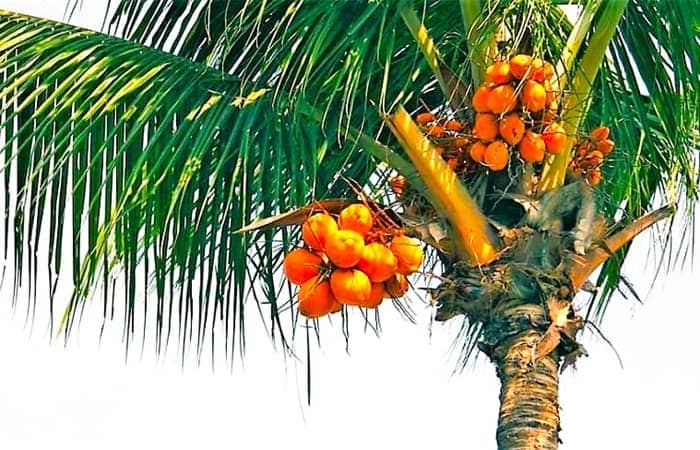 Some Varieties of Coconut Palms Have Orangey-Red Coconut Fruit, Like Here
Some Varieties of Coconut Palms Have Orangey-Red Coconut Fruit, Like HereWhere is the Seed in a Coconut?
Do you wonder about Palm Trees vs Coconut Trees?
That's something to know in understanding this coconut Palm Fruit, to answer the question of how do Coconuts grow. It all begins with the seed. Where exactly is the coconut seed?
Would you be surprised to learn that these Parts of Coconut Palm structure - the entire coconut - is the seed? Yep, that's right, the whole thing!
So what palm trees grow coconuts? It's Cocos nucifera (the coconut palm scientific name) that produces the Delicious Edible Fruit of the Coconut Palm.
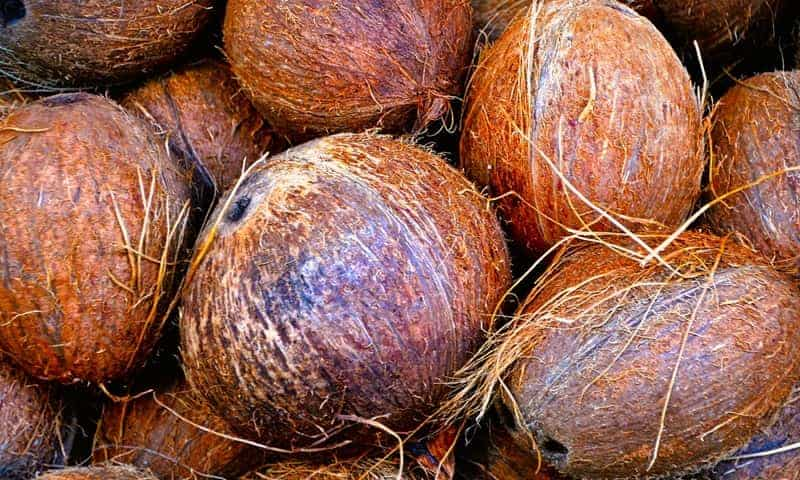 A Bunch of Coconuts - The Coconut Palm's Seeds
A Bunch of Coconuts - The Coconut Palm's SeedsIf the coconuts aren't being eaten, then, will coconut seeds grow into palms?
That's quite possible! We'll show you:
- What Coconut parts play the major growing role.
- The right steps for coconut palm seeds to grow.
- How coconut palm trees get from a sprout to an adult.
The Coconut Growth Timeline
A parent coconut palm can begin coconut fruiting processes as early as 3 years old.
But usually taking 6-10 years. Then providing 50-200 coconuts over a year. Fruiting quantities begin a downward trend after the first 35 years. Old age (senescence) starts about age 80, when fruiting often stops.
Coconut Seed - Fruit Structure
The fruits are green, initially.
Then while maturing, the thin stringy shell (exocarp) begins turning brown.
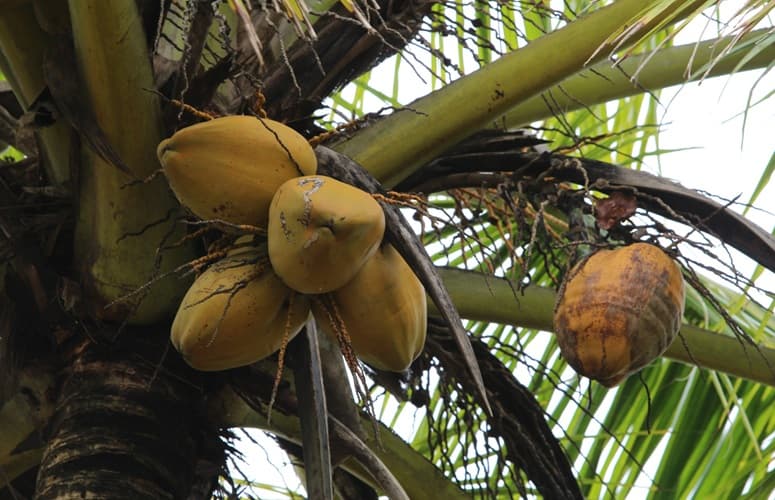
The next layer is the mesocarp, a matted level, often called "coir." Next is the hardest layer: the endocarp.
You're likely most familiar with the next & innermost layer, the endosperm. That's the edible coconut meat, where the plant embryo is implanted.
Then there's an inner cavity, nearly filled with liquid, the coconut milk (or water). As the coconut ages, much of the liquid is absorbed. After about a year of maturing, there's still enough left to hear a sloshing sound when shaken. That's when it's ready for planting.
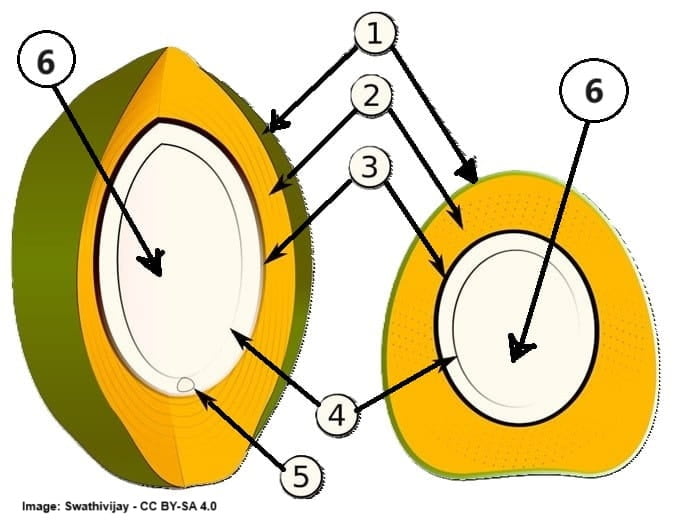 Coconut Seed Layers: 1) Epicarp, 2) Mesocarp, 3) Endocarp,
Coconut Seed Layers: 1) Epicarp, 2) Mesocarp, 3) Endocarp,4) Solid Endosperm, 5) Embryo 6) Liquid Endosperm
Understand the Coconut Germination Steps
The best time of year to plan coconut seed is the summer. Because it's the warmest, wettest season. But with the proper climate any time of the year is fine.
FIRST, soak the coconut in water for 2-3 days. While that's happening, prepare a planting hole. Dig it 3ft/1m around & about 1ft/30cm deep. (Don't forget to check locations of underground utilities!)
SECOND, one end of a mature coconut, has three "eyes". They're softer sunken areas. Important to locate, because the embryo is under the softest eye.
THIRD, place the nut/seed, in your dug-out hole. Cover the ends with about 4in/10cm of soil. Leave the middle third portion exposed. Keeping the eyes below the soil. Gently water the area, while ensuring the planting area has good drainage.
Normally it's quite happy with this environment. So it soon begins germination.
- Unseen by you, the embryo starts expanding, creating a whitish cover around it.
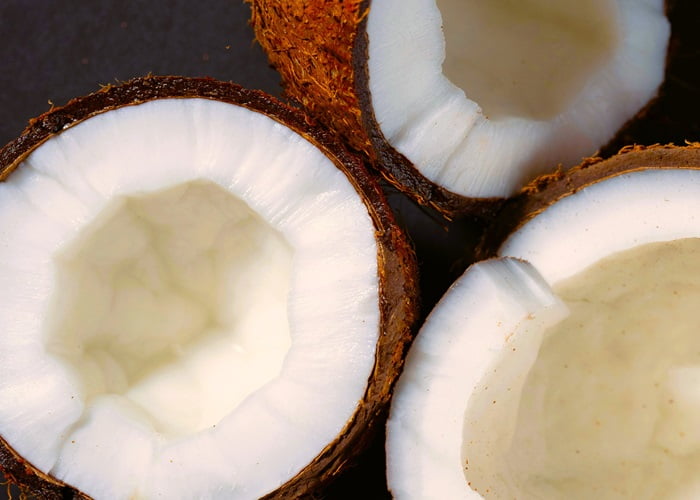 The endosperm's meaty layer of white copra serves as food for the growing seedling.
The endosperm's meaty layer of white copra serves as food for the growing seedling.(Not to Mention People!)
- A green shoot shows itself: beginning the coconut tree's trunk.
- Soon the root appears! Over the next month or so, the coconut seed sends out more roots. Anchoring itself into the ground.
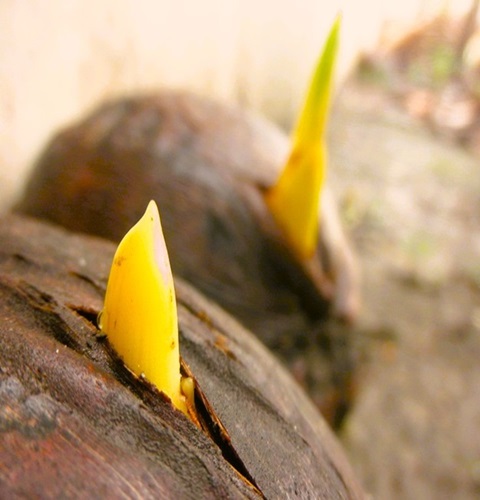 The Seedling is Just Beginning
The Seedling is Just Beginning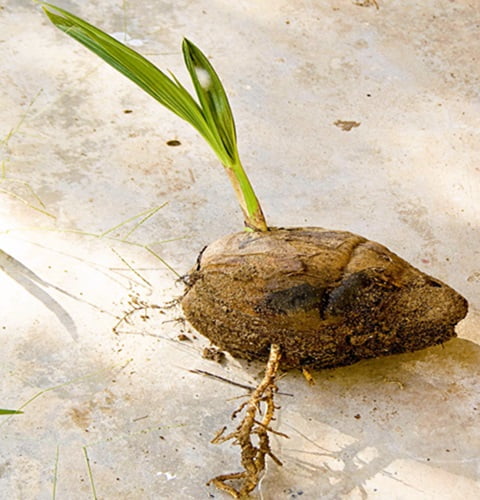 There's the roots. Then Came the Green Sprout.
There's the roots. Then Came the Green Sprout.Your watering plan: at least twice a week. Be sure of good drainage. Coconut palms like lots of watering, but not soggy roots.
As long as they have their ideal conditions, they'll start youthful growth quite quickly. Then slow down a little.
The Coconut Palm Development
The coconut germination process takes 3 to 7 months.
The first shoot grows upward with a few green solid leaves. It's the new growth spear.
This stem gradually becomes the coconut palm's trunk, over about 5 years. Eventually forming coconut palm frond clusters: the crown. Then finally growing quite tall (90-100ft/27-30m).
Fruits can be produced even before that full growth height begins! Yellowish flowers are crammed along a stalk (inflorescence). Fertilized flowers become the coconut fruit/seed.
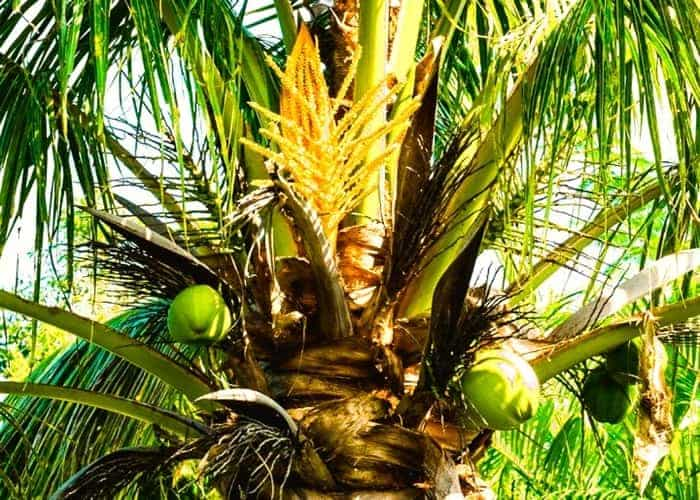 New Yellow Flowers Pose Amid Already Formed Coconuts
New Yellow Flowers Pose Amid Already Formed CoconutsIt's a continuous ongoing process.
- Coconut seed to sprouting growth.
- The leaves form the characteristic feathery look. As a pinnate leafed palm.
- The height increases to 15-30ft/38-76cm.
- While fairly soon getting to producing flowers. Which brings the new coconut fruits to life.
Then it starts all over again.
Fruit of Labor - Maturation & Harvesting of Coconuts
So, you see, a single coconut seed grows a towering, productive palm.
A cycle going on for millions of years.
After a year, when ripe, mature coconuts fall to the ground. Happening almost continuously now, as flowering & fruiting happens throughout the year. You'll also see some fallen coconuts beginning to sprout - right on the ground's surface!
Are you thinking of growing a coconut palm tree.
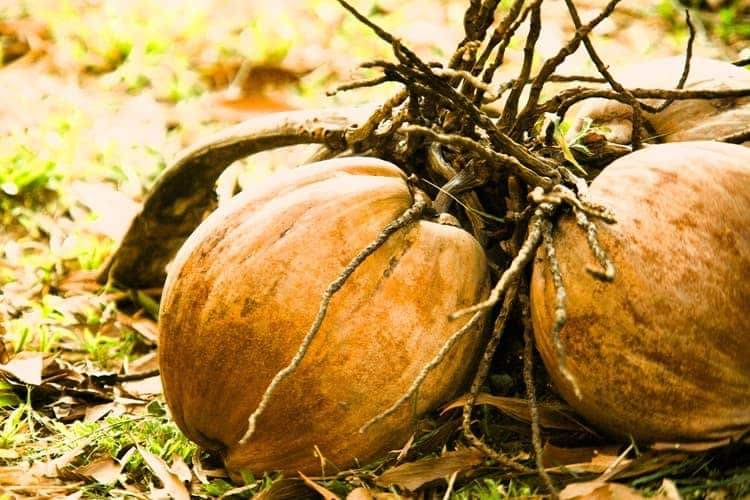
Growing Your Own Coconuts
Isn't it tempting to have a go at Growing Your Own Coconut Palm? Being part of the coconut's journey from a single seed to a mature, fruit-bearing palm? A delightful thought, isn’t it?
Learning how do coconuts grow can be incredibly rewarding.
Beyond the Harvest - The Lifecycle Continues
Through the centuries, today's coconut palms still have the same traits as those original wild palms. Even though they're Grown for Many Products, coconut palms haven't been entirely tamed!
While attempting its palm growth, the germinating coconut cannot dry out. Yet their life continues, for the love of this big (2nd biggest of any seed), oily, chewy, milky fruit.
Coconut Palm Care for Good Growth
Coconuts need warm temperatures for sprouting.
Temperature Range for How Do Coconuts Grow Successfully
Their native environment isn't confirmed. But coconut palms probably originated on South Pacific Island coastlines.
The best temperatures ranges from 81-100°F/27-38°C. So, think tropical weather. Meaning they grow between north & south of the equator to 26° latitudes. Doing well in the USDA Growing Zones 10b-11, or equivalent.
Possibly they'll survive exceedingly short temp dips. But not less than 41°F/5°C.
It's also a Palm for Full Sun, easily done in the tropics.
How Much Moisture do Coconut Palms Need?
Coconut palms like rainfall of about 79in/2m yearly.
Regularly watering the coconut palm is best. There's almost no such thing as overwatering for coconut palms. As long as there's good drainage. Waterlogged roots can't send nutrients up the palm.
Coconuts also require high humidity. Think of the sultry, balmy feel of the tropics. Where we all start sweating without much activity.
Yet they can tolerate limited drought.
Nutrition Problems of Coconut Palms
When thinking how do coconuts grow, don't worry much for the soil the coconut palm lives in. You could test for pH first, but really, they're not fussy.
If you're planting one, mix in organic matter for even better growth & health.
Try to avoid Palm Health Problems from nutritional needs. Prevent that by using controlled-release Palm Specialized Fertilizer. Ideally these proportions: 8N-2P-12K. Plus up to 12% Iron & Magnesium, with traces of Zinc, Boron & Copper. This Florida Source has good palm fertilization info you can download for reference.
There are at least nine form varieties. Growing up to various heights. With assorted fruit & leaf colors. Each has differing weaknesses for temp drops, nutrition & attack from lethal yellowing.
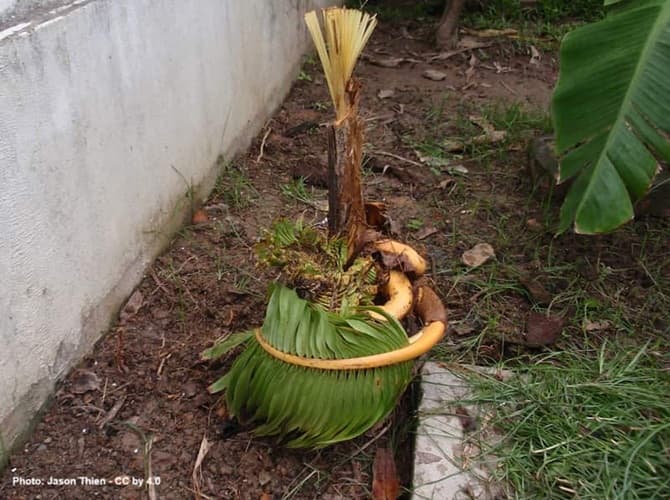 Crazily Twisted Young Malayan Red Dwarf Coconut Palm
Crazily Twisted Young Malayan Red Dwarf Coconut PalmCoconut Palms Enduring Extreme Weather
Hurricanes & typhoons hit coconut palm growing areas yearly. These high winds aren't much of a problem. Especially if the palms are well cared-for, with solid roots.
During storms, lightning could strike them. Attracted by their tall structure. That event could kill a coconut palm.
 Watch it! A storm's coming in.
Watch it! A storm's coming in.They say use caution when under a coconut palm. It's rare, but coconuts have crashed onto people's heads. Yikes! So be aware 👍.
 OH NO! Watch out!! 😮
OH NO! Watch out!! 😮Takeaways for How Do Coconuts Grow
Understanding how do coconuts grow opens a door to a deep appreciation for these ancient, complex fruits.
From beginning as a seed reacting to moisture & warmth, developing a sprout, then roots, a growing trunk, then fronds & flowers. And finally fruit. How about nurturing this wonder in your own backyard?
Even if not, or unable to grow your own coconut tree - you'll sometimes think of being amidst all those coconut palms, in Some Tropical Place! Since we live in the desert, that's our style of travel!





